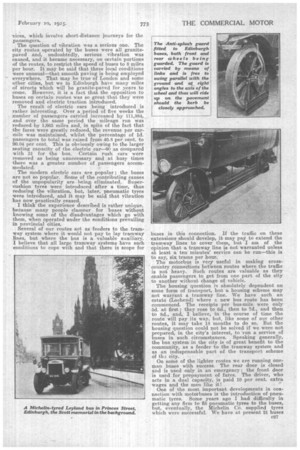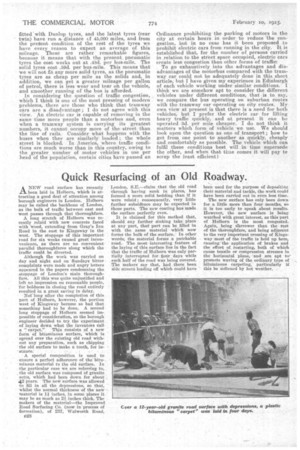EDINBURGH'S EXPERIENCES WITH BUSES.
Page 10

Page 11

Page 12

If you've noticed an error in this article please click here to report it so we can fix it.
A Municipal Transport Service Which Carries Nearly 19 Million Passengers Annually and Which Runs at a Profit.
By R. Stuart Pitcher, M.Inst.T., Engineer and Manager, Edinburgh Corporation Tramways.
MEM Edinburgh Corporation operates 87 motor1 buses, in addition to 350 electric cars. The type of bus used is that Jknown as the Edinburgh type, and was first supplied by Leyland Motors, Ltd., to the Edinburg'i Corporation. The body is fitted with
both a front and rear en:eance and has seating accommodation for 31 passengers. The chassis and engines are of the Leyland type, 36-40 h.p., and A.E.C. type, 45 h.p., the Associated Equipment Co., Ltd., having supplied a portion of the fleet.
For the year ended May 15th, 1924, the total receipts were £132,238 ; the mileage was 1,857,535 and the number of passengers carried 18,39,780; the average speed was 8.25 m.p.h. ; the working expenses ,--15.34d. per bus-mile. The bus services consist of :- (1). Routes not physically suitable to be operated as tramway routes.
(2) Routes acting as feeders to the tramway
system., : • .
(3) Routes where the traffic is too light to warrant the laying of tramway lines: . .
(4) Routes of • the cross-country type connecting tramway routes together: Buses are also used extensively for special events such as football matches, and ibis frequently neces
sary to run as many as 30 extra bu-ses on one particular route to supplement the existing service. Special buses are also run during the night to pro
vide facilities for dances, etc. For the Marine Gardens ballroom( as many as 14 special buses are run at 1.30 a.m. from Portobello. A through ticket is issued which includes entrance to the dance hall and bus ticket home.
Popular tours are run by 14 char seir-banes during the sum• mer. Five tours a r e arranged, the prices ranging from 2s. for 18 miles to is. for 10 miles. The tours are confined to the city, but as the city has an area of 32,000 acres, which includes a great deal of beautiful country, there is ample scope for popular tours. The revenue derived from tours
last year was
£4,422; the mileage run. was 37,962. 026
The experience derived from the fleet of buses during the past five years has been very extensive. The buses were used, in he first place, to operate city tramway routes which were temporarily closed down.
The service of buses on these routes was as frequent as three minutes. The revenue per busmile was 23.07d. and the passengers per bus-mile 14.82, so that the routes were, in every sense, city routes. The experience ,obtained clearly proves that, on these routes, the public, for various reasons, prefers electric cars to motorbuses: Although the people on these routes were accustomed, previously, to an obsolete cable system, they did not take kindly to the buses. .
On a city route, with id. fares in operation, it was inevitable thait crowding and congestion should take place at certain periods of the day. At these times the buses were uncomfortable, and occasionally the whole of the passengers could not be accommodated. With a vehicle restricted to a seating capacity of 31 passengers, it is unavoidable that inconvenience should arise, as it is not always possible to provide extra vehicles to eater for unusual traffic. This undoubtedly constitutes one of the disadvantages of the bus.
A further disadvantage is that unless wide doors and easy steps are provided the schedule speed of the vehicle is reduced. We had a specific example of this on the Mound route where, pre
viously, 4 h e cable cars averaged a speed of 5i miles per hour. When the buses were introduced w e anticipated that
h e schedule speed would be considerably increased owing to the higher maximum speed of the bus, but to our surprise the same number of buses was required, t h e reason being that, although the buses ran quicker between the stops, they took longer to load and to unload than the
cable cars, which were provided with easy steps and spacious doors. I mention this to emphasize t h e importance o .f providing specially easy means of entrance and exit for city ser
vices, which involve short-distance journeys for the passengers.
The question of vibration was a serious one. The city routes operated by the buses were all granitepaved and, undoubtedly, serious vibration was caused, and it became necessary, on certain portions of the routes, to restrict the speed of buses to 8 miles per hour. It may be said that these local conditions were unusual—that smooth paving is being employed everywhere. That may be true of London and some other cities, but we in Edinburgh have many miles of streets which will be granite-paved for years to comeHowever, it is a fact that the opposition to buses on certain routes was so great that they were removed and electric traction introduced.
The result of electric cars being introduced is rather interesting. Over a period of five weeks the number of passengers carried increased by 111,384, and over the same period the mileage run was reduced by 1;865 miles and, in spite of the fact that the fares were greatly reduced, the revenue per carmile was maintained, whilst the percentage of 1d. passengers to total was raised from 40.8 per cent. to 90.04 per cent. This is obviously owing to the larger seating capacity of the electric car-60 as compared with 31 for the bus. Certain rush cars were removed as being unnecessary and at busy times there was a greater number of passengers accommodated.
The modern electric cars are popular ; the buses are not so popular. Some of the contributing causes of the unpopularity are being. eliminated. Supercushion tyres were introduced after a time, thus reducing the vibration, but, later, pneumatic tyres were introduced, and it may be said that vibration has now practically ceased. I think the experience described is rather unique, because many people clamour for buses without knowing some of the disadvantages which go with them, when operated under the conditions prevailing in provincial cities.
Several of our routes act as feeders to the tramway system where it would not pay to lay tramway lines, but where the bus is a valuable auxiliary. I believe that all large tramway systems have such conditions to cope with and that there is scope for buses in this connection. If the traffic on these extensions should develop, it may pay to extend the tramway lines to cover them, but I am of the opinion that a tramway line is not warranted unless at least a ten minutes service can be run—this is to say, six trams per hour. The motorbus is very useful in making cresscountry connections between routes where the traffic is not heavy. Such routes are valuable as they enable passengers to get from one part of the city to another without change of vehicle.
The housing question is absolutely dependent on some form of transport, but a housing scheme may not warrant a tramway line. We have such an estate (Lochend) where a new bus route has been commenced. The receipts per bus-mile were only 5d. at first ; they rose to 6d., then to 7d., and then to 8d., and, I believe, in the course of time the route will pay its way, but, like some of our other routes, it may take 18 months to do so. But the housing question could not be solved if we were not prepared, in the city's interest, to run a service of buses in such circumstances. Speaking generally, the bus system in the city is of great benefit to the community, as a feeder to the tramway system and as an indispensable part of the transport scheme of th3 city. On some of the lighter routes we are running oneman buses with success. The rear door is closed and is used only in an emergency; the front door is used for prepayment of fares. The driver, who acts in a dual capacity, is paid 10 per cent. extra wages and the men like it I One of the most important developments in connection with motorbuses is the introduction of pneumatic tyres. Some years ago I had difficulty in getting any firm to fit pneumatic tyres to the buses, but, eventually, the Michelin Co. supplied tyres which were successful. We have at present 21 buses
fitted•with Dunlop tyres, and the latest tyres (rear twin) have run a distance cf 45,000 miles, and from the pregent condition of the rest of the tyres we have every reason to expect an average of this mileage. These are rather remarkable figures, because it means that with the present pneumatic tyres the cost works out at .43d. per bus-mile. The solid tyres cost .59d. per bus-mile. This means that we will not fit any more solid tyres, as the pneumatic tyres are as cheap per mile as the solids and, in addition' we can get a greater mileage per gallon of petrol, there is less wear and tear on the vehicle, and smoother running of the bus is afforded. In considering the question of traffic congestion, which I think is one of the most pressing of modern problems, there are those who think that tramway cars are a disadvantage ; I do not agree with this view. An electric car is capable of removing in the same time more people than a motorbus and, even when a tramway system is carrying its greatest numbers, it cannot occupy more of the street than the line of rails. Consider what happens with the buses when they are similarly loaded ; the whole street is blocked. In America, where traffic conditions are much worse than in this country, owing to the greater, number of motor vehicles in use per head of the population, certain cities have passed an
Ordinance prohibiting the parking of motors in the city at certain hours in order to reduce the congestion, but in no case has it been proposed to prohibit electric cars from running in the city. It is established that, for the number of persons carried in relation to the stieet space occupied, electric ears create less congestion than other forms of traffic: To go exhaustively into the advantages and disadvantages of the motorbus compared with the tramway car could not be adequately done in this short article, but I have given my experience in Edinburgh of each vehicle working under similar conditions. I think we are somehow apt to consider the different vehicles under different conditions, that is to say, we compare the bus operating on suburban routes with the tramway car operating on city routes. My own view at present is that there is a need for both vehicles, but I prefer the electric car for lifting heavy traffic quickly, and at present it can be operated 3d. per mile cheaper. I do not think it matters which form of vehicle we use. We should look upon the question as one of transport ; how to get from one point to another as quickly, cheaply and comfortably as possible. The vehicle which can fulfil these conditions best will in time supersede the other, and when that time comes it will pay to scrap the least efficient!














































